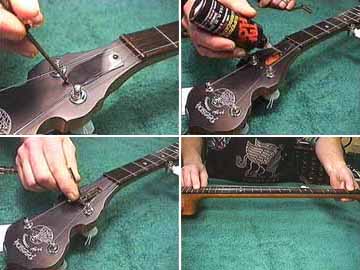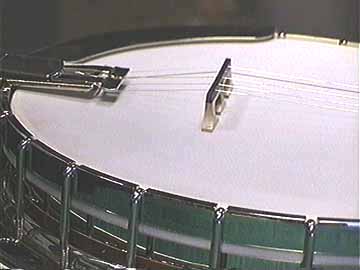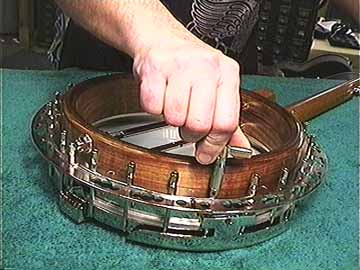Page 1 of 4
How to deal with
Banjo Coordinating Rods
© Frank Ford, 6/3/98; Photos by FF, 6/1/98
Here's a topic that needs a lot of preparation. Coordinating rods are a bit confusing
at first, but they are really a very straightforward means of adjusting and maintaining
a banjo's neck angle.
First, it's important to understand that the truss rod and coordinating rods are
not related in any way. The truss rod's job is to control the shape of the neck:
to adjust the "relief" or curvature and to keep the neck from warping.
Before even looking at the coordinating rods, I always check the truss rod adjustment
by mashing the strings down (while tuned to pitch) at the first fret and at the 19th
or so:

I want to see about 0.010" or a little more clearance between the string and
the middle frets. This "relief" is necessary to avoid buzzing, and may
need to be increased for a heavy handed player. If I'm making any adjustment to the
truss rod, I'll back the nut way off and lubricate the threads. That way I'm not
fighting excess friction when adjusting the nut.
Some banjos have "two way" adjustable rods with non-removable nuts.
These usually can't be lubricated, so I just accept them the way they are! When checking
truss rod adjustments, I try to hold the banjo in a reasonable semblance of playing
position, so I don't flex the neck unnaturally.
With the truss rod properly adjusted, I turn my attention to the
head and bridge. Before messing with the coordinating rods, I make sure that I have
the desired height bridge in the right location:

Head tension really affects action, so I'm sure to check that while I'm at it:

Just a couple more items.
First, look at the complex joint where the neck fits the banjo shell:

The neck contacts the shell at three different "levels" on this Gibson
Mastertone. It's important that the neck fits tightly and can't be shifted while
the banjo is in use.
I'll mention oil one more time and then shut up:

Banjos are bolted together everywhere. Generally, the threads on banjo parts are
not the highest quality machine work, and they're often a bit clogged with heavy
plating. Older instruments may have a bit of rust or corrosion on the threads.
I OIL ALL SCREW TREADS ON BANJOS. That means all fittings, including all 24 head
tensioning hooks, resonator mounting thumbscrews, etc.
Speaking of resonator screws, let's take the resonator off and look at some coordinating
rods. . .
More
1
2
3
4
Back to Index Page